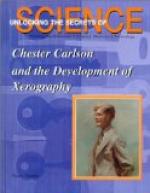|
This section contains 321 words (approx. 2 pages at 300 words per page) |
World of Invention on Chester Floyd Carlson
Chester F. Carlson's life was one of hard work and diligence that paid off. At age 14 Carlson supported his ailing parents by working odd jobs. He attended college at night, graduating in 1930 from California Institute of Technology with a B.S. in physics. After working with Bell Telephone Laboratories, Carlson labored in the patents department of a New York electronics firm and began studying patent law at night. To save money, he copied longhand from borrowed textbooks. By day Carlson spent much time obtaining copies of blueprints and patent descriptions. Because of his experiences of hand copying, Carlson set out to develop a quick and inexpensive duplicating process. Within three years, Carlson received his own "electrophotography" patent. He and a young German physicist and engineer, Otto Kornei, Carlson worked on his system to electrostatically produce copies. Using a mirror Carlson projected an image onto a electrically charged drum coated with selenium. Because selenium will only hold an electric charge in the dark, the charge remained exclusively on the areas where the dark sections of the image were reflected. Carlson then coated the drum with a powder made of carbon and thermoplastic resin. Rolling an electrically charged sheet of paper along the drum released the image onto the paper, where it was fused into a permanent impression by infrared light. In his laboratory on October 22, 1938, Carlson made the first copy of an original document using the process he called xerography, from the Greek for "dry writing." After a six-year search for a backer, in 1947 the Haloid Company purchased the rights to Carlson's photocopier. Haloid, which was renamed Xerox Corporation, hit its stride 12 years later when on September 16, 1959 it introduced its first automatic plain-paper copier, the Xerox 914. Chester Carlson became a very wealthy man and philanthropist, who during his lifetime he donated over $150 million to worthy causes. On September 19, 1968, Carlson died of a heart attack in a New York movie theater.
|
This section contains 321 words (approx. 2 pages at 300 words per page) |


